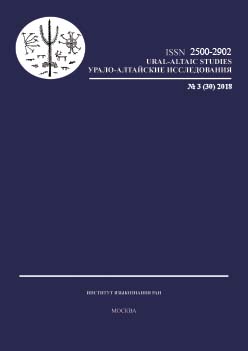Стратегии кодирования предикативной посессивности… в приуральском и казымском диалектах хантыйского языка
Strategies of encoding predicative possession
in the Priural and Kazym dialects of the Khanty language
Author(s): Victoria Vorobeva, Irina NovitskayaSubject(s): Sociolinguistics, Finno-Ugrian studies
Published by: Институт языкознания Российской академии наук
Keywords: Khanty language; Priural (Obdorsk) dialect; Kazym dialect; predicative possession; habeo-verb;
Summary/Abstract: The article presents research findings resulting from an analysis of the strategies used to encode predicative possessive relations which were identified in a corpus of texts (62 texts, 5181 sentences) in the Priural (Obdorsk) and Kazym dialects of Khanty language. The most common strategy of encoding predicative possession in Priural (Obdorsk) and Kazym dialects is a transitive one based on the verb sob. tăjtĭ, pol. täjtĭ, kaz. tăjtĭ ‘to have’, which is used to express the main conceptual features of possession (abstract, physical / temporal, alienable, inalienable, inanimate). An intransitive strategy can be represented by the construction that is based on the locative / existential sentence with the verb sob. u(l)tĭ, pol. o(l)tĭ, kaz. wŏ(ł)tĭ ‘to be’. Following L. Stassen, it is defined as an adnominal possessive construction wherein the possession is indexed on the possessed. Negative possession is encoded differently in the transitive and intransitive strategies. While the “standard” syntactical negation, expressed by the negative particle sob. ăn, pol. ǟn, kaz. каз. ăn, χŏn ‘no, not’, is used in the transitive strategy, a special negative existential verb ― sob. ăntam, pol. äntam, kaz. Ăntŏm “not to be” ― is common in negative intransitive constructions.
Journal: Урало-алтайские исследования
- Issue Year: 2018
- Issue No: 03 (30)
- Page Range: 7-32
- Page Count: 26
- Language: Russian

